When Removing a Self Adhesive Stencil What Can They Be Placed on to Be Used Again

BASIC One Color
Basic One Color Stenciling: Learn How To Stencil With A Roller And A Stencil Castor
Stenciling is easy when you follow a few basic guidelines!
If y'all properly ready the surface to be stenciled and use the proper tools and techniques, your stenciling project should be a fun and rewarding feel. Not to mention how much money you tin can save with DIY decorating. Whatsoever mistakes are easily correctible so allow'south become and stencil something!
What You'll Demand
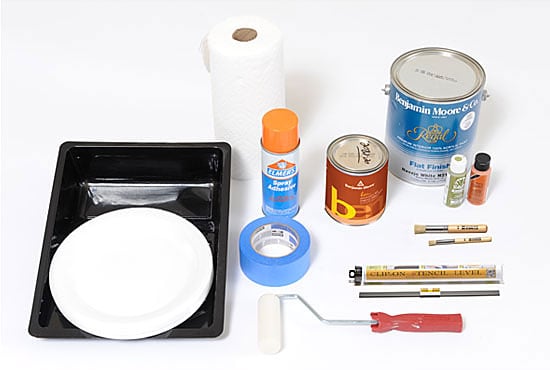
- Your Cutting Border Stencil
- Stencil Paint (latex or acrylics)
- Base of operations Glaze Paint (for touch-ups)
- Depression Tack Painters Record
- Stencil Brush
- Dense Foam Roller
- Pigment Tray or Paper Plate
- Paper Towels
- Spray Agglutinative (optional)
- Cutting Edge Stencil Clip-on Level (optional)
- Sample Board (cardboard or poster board) (optional)
Preparing Your Walls
Brand sure that the walls you'll exist stenciling are properly prepared! It makes no sense to put your beautiful artwork over a poorly prepared surface. Walls should be clean, dust gratuitous and in good condition. Any cracks or chips should be repaired, filled, primed and painted prior to stenciling. Base of operations coat paint should exist immune to dry for at least 24 hours before stenciling. We recommend a Apartment sheen base coat paint for best results. You lot tin can stencil over eggshell sheen likewise but the general dominion is, the higher the sheen of the base coat, the more potential for paint seepage to occur. We do non recommend stenciling textured walls as paint seepage tin can occur. The employ of spray adhesive is not necessary only for some more fragile stencils or stencils with large cutouts it tin can be helpful. Spray agglutinative is recommended for ceiling stenciling.
Masking
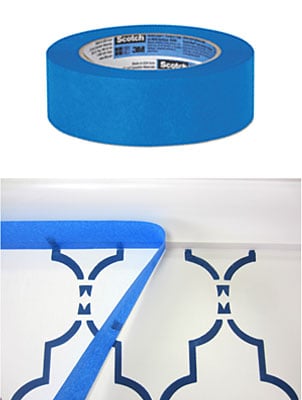 When stenciling, we usually use a low tack painters tape such as 3M blue record to avoid pulling up any base coat pigment. For walls, mask off the baseboards, moldings, ceilings and those surfaces that volition not be stenciled Burnish (rub down) the edge of the record for a cleaner line with less paint seepage. Always remove your masking tape slowly, pulling it an an angle.
When stenciling, we usually use a low tack painters tape such as 3M blue record to avoid pulling up any base coat pigment. For walls, mask off the baseboards, moldings, ceilings and those surfaces that volition not be stenciled Burnish (rub down) the edge of the record for a cleaner line with less paint seepage. Always remove your masking tape slowly, pulling it an an angle.
A Few Words About Paints
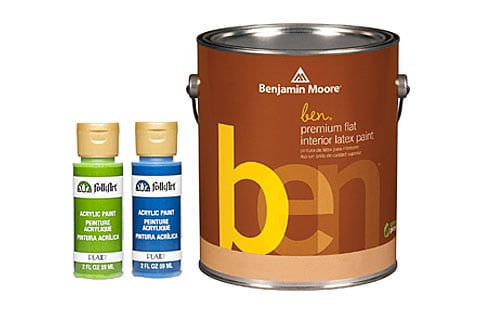 Primer
Primer
If your walls are in need of repairs (cracks, holes, blast pops etc) get-go fill or spackle those areas, allow them dry and then sand them smooth with fine (220) sand paper. Brand sure you dust off the repairs earlier priming them. You can besides wipe the repairs with a damp towel to remove any dust. Applying a Waterbased Drywall Primer to the repairs will help ensure proficient paint adhesion. Good paint adhesion is of import because you will be taping the stencil to the wall and you desire to prevent the record from pulling off the base coat paint. Permit the primer dry out fully before applying
Base paint
At Cut Edge Stencils, nosotros recommend base of operations coating your walls with a flat sheen, water based paint using a tight nap roller for a smooth finish. Flat sheen paints accept the stenciling meliorate so shinier paints. Flat sheen pigment is porous, so it grabs your stencil paint before it has time to seep (bleed) under the edge of your stencil resulting in a crisper print. Flat paints are easier to touch up as well. Considering they are not shiny, they tend to blend amend without flashing. (Flashing is a term that describes a difference in sheen that occurs when trying to touch up higher sheen paints such equally a semi-gloss.) Then if you ever make a mistake stenciling your walls, it'due south easy to paint over the mistake with a flat sheen pigment and then re-stencil the surface area with great results.
Stencil Pigment
For walls, we recommend a skillful quality Acrylic or Latex paint. Craft acrylics too work great. We also like Benjamin Moore "Ben" flat pigment for stenciling walls. It gives a peachy result and is a good value. Nosotros don't recommend using spray paint as it'due south difficult to control. Oil based paints are too not stencil-friendly. You can stencil with metallic paint, glaze or even plaster.
Using Spray Agglutinative
Spray adhesive tin can give you crisper stenciled edges simply it is not necessary to use it for stenciling. If a stencil is frail, or has large cutting outs, spray agglutinative can help to concur the stencil in place and attain better results. Select a repositionable adhesive (like Elmer'south) and spray the back of the stencil with an fifty-fifty coat. Do this in a well ventilated expanse and exist careful almost overspray. Let the adhesive dry for a few minutes so information technology doesn't transfer to the projection's surface. Reapply spray adhesive equally necessary during stencil project.
Choosing Your Colors
Look at some reference for color combinations that work well together and do a exam sample then you are comfortable with your choices. Ever take into consideration your givens, such as existing fabrics, floor or carpet colors. We love using white alphabetize cards for color swatches.
Sample Test
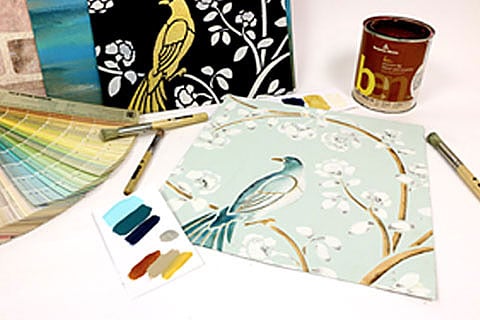 Information technology is e'er a good idea to examination your stenciling technique and color selections before starting your project. You tin can examination your stencil and colors in a discreet place on your wall only it's best to brand a sample board. Y'all can use a piece of cardboard, a pizza box, a piece of sheetrock or a piece of plywood for your sample. Yous'll demand to base of operations glaze the sample material in the same paint as your wall. Then you can exercise a few prints to get comfortable with your technique. You tin can also test the sample in different areas of the room to see how calorie-free might affect the colour. And finally, y'all'll accept a sample that you lot can bring with you when shopping for fabrics and piece of furniture to go with your beautifully stenciled walls!
Information technology is e'er a good idea to examination your stenciling technique and color selections before starting your project. You tin can examination your stencil and colors in a discreet place on your wall only it's best to brand a sample board. Y'all can use a piece of cardboard, a pizza box, a piece of sheetrock or a piece of plywood for your sample. Yous'll demand to base of operations glaze the sample material in the same paint as your wall. Then you can exercise a few prints to get comfortable with your technique. You tin can also test the sample in different areas of the room to see how calorie-free might affect the colour. And finally, y'all'll accept a sample that you lot can bring with you when shopping for fabrics and piece of furniture to go with your beautifully stenciled walls!
Positioning Your Stencil
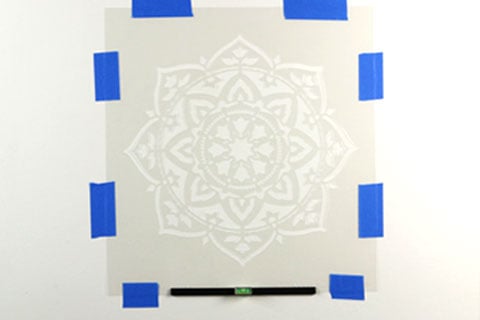 Identify your stencil on the wall where yous like. Utilise several pieces of low tack painters record to secure the stencil. Don't use regular masking tape as it's way too sticky and tin can pull off the base of operations coat when yous move your stencil. If your stencil needs to be level, use our innovative Prune On Stencil Level. The level is so lightweight it tin stay clipped to the stencil while y'all work. Leveling is not necessary for organic designs like branches, birds etc. For stencil designs like these, only place them by eye. For ceilings, the method is the aforementioned but nosotros do recommend the use of spray adhesive in improver to the low tack painters tape to help agree the stencil in place.
Identify your stencil on the wall where yous like. Utilise several pieces of low tack painters record to secure the stencil. Don't use regular masking tape as it's way too sticky and tin can pull off the base of operations coat when yous move your stencil. If your stencil needs to be level, use our innovative Prune On Stencil Level. The level is so lightweight it tin stay clipped to the stencil while y'all work. Leveling is not necessary for organic designs like branches, birds etc. For stencil designs like these, only place them by eye. For ceilings, the method is the aforementioned but nosotros do recommend the use of spray adhesive in improver to the low tack painters tape to help agree the stencil in place.
Stenciling With a Dumbo Foam Roller
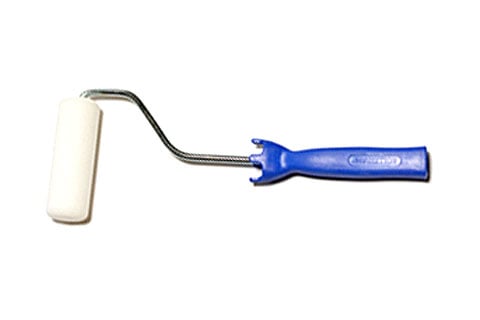 This is a super fast way to get the job done. Perfect for walls! Pour your stencil paint into a tray or plate and EVENLY load your Dense foam roller by rolling it a few times back and along through the poured paint. We don't want a blotchy looking roller. One time your stencil roller is evenly saturated with paint, off load the backlog pigment past rolling information technology a couple times on folded paper towels. If the roller leaves stripy lines on the paper towels, reload the roller so it's evenly coated and and then off load it once again on your folded paper towels. The roller should announced somewhat dry out. It's always better to have less paint on your roller because too much paint tin cause paint bleed.
This is a super fast way to get the job done. Perfect for walls! Pour your stencil paint into a tray or plate and EVENLY load your Dense foam roller by rolling it a few times back and along through the poured paint. We don't want a blotchy looking roller. One time your stencil roller is evenly saturated with paint, off load the backlog pigment past rolling information technology a couple times on folded paper towels. If the roller leaves stripy lines on the paper towels, reload the roller so it's evenly coated and and then off load it once again on your folded paper towels. The roller should announced somewhat dry out. It's always better to have less paint on your roller because too much paint tin cause paint bleed.
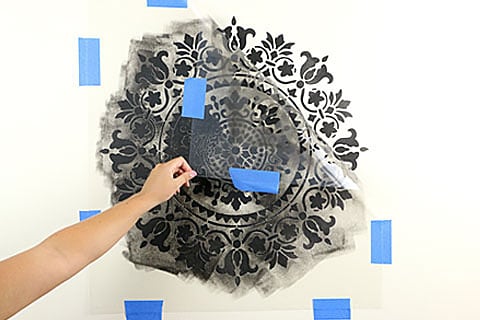
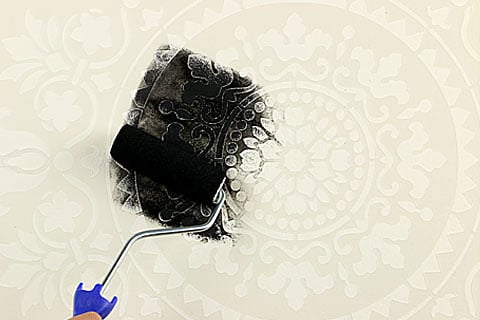
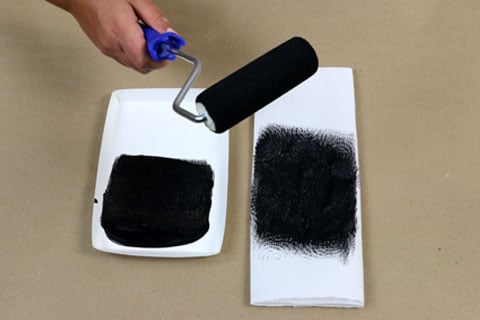
Near Pigment Bleed or Paint Seepage
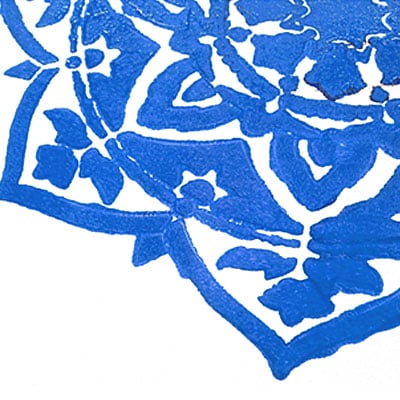 Stencil drain occurs when paint seeps under the border of the stencil leaving a less than perfect impress. Don't worry about this too much, only do accept measures to reduce the amount of bleed. Know that there will always be some minor bleed here and there every bit we're creating a hand-painted finish. But when the wall is done and you lot expect at the entire project your heart will see the colour and the design. In most cases y'all wouldn't even notice a picayune bleed. But we withal want to keep drain to a minimum so nosotros follow these guidelines:
Stencil drain occurs when paint seeps under the border of the stencil leaving a less than perfect impress. Don't worry about this too much, only do accept measures to reduce the amount of bleed. Know that there will always be some minor bleed here and there every bit we're creating a hand-painted finish. But when the wall is done and you lot expect at the entire project your heart will see the colour and the design. In most cases y'all wouldn't even notice a picayune bleed. But we withal want to keep drain to a minimum so nosotros follow these guidelines:
Employ a flat base coat paint. Utilize a flat stencil paint similar "Ben". Make certain the wall is polish without a texture. Don't overload your stencil roller and build the paint coverage upward slowly, without pressing hard on the roller. Employ spray agglutinative for even crisper edges. Minor mistakes and bleed can exist wiped off with babe wipes or moist rag while the mistake is still fresh. Alternatively, the mistakes tin be touched up later with a pocket-size brush.
Stenciling with a Castor
Using a stencil brush works great for article of furniture, craft projects, shading and multicolor designs. And also for edges and corners when stenciling walls. Select your stencil brush size based on the size of the stencil openings.. The smaller the openings - the smaller the brush. For edges and corners a regular size stencil brush (1/two" or 5/8") works well.
Cascade your stencil pigment onto a tray. Dip the stencil castor tip into the paint (only about 1/8") and so swirl it on the tray to evenly distribute the paint into the bristle tips. Off load the excess paint onto some folded paper towels. Like the roller, the brush should announced most dry. Y'all can use a light swirling motion for a softer look and for shading. Pouncing (straight up and down motion) works great for filling in areas. When stenciling with multiple colors, use a specific brush for each color to avoid colour contamination.
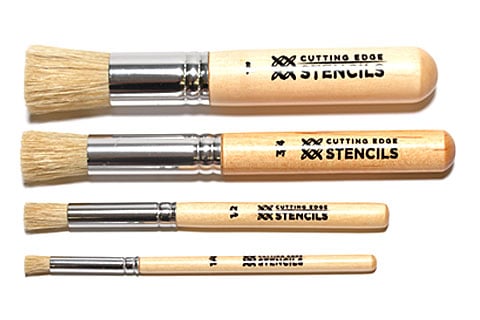
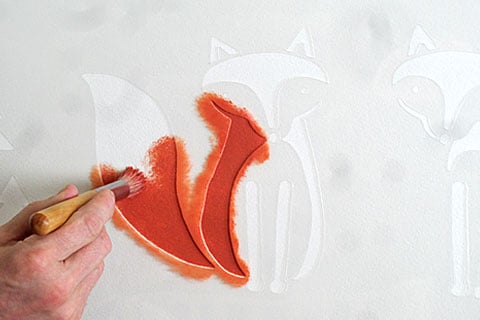
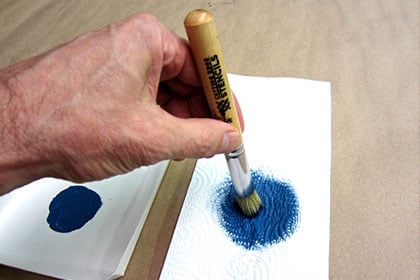
Stenciling Around Moldings And Edges
For baseboards, window and door moldings simply mask off the moldings and bend the stencil into the crease, using pieces of record to help secure it if necessary. Roll right into the crease and then use a Stencil castor to detail the border.
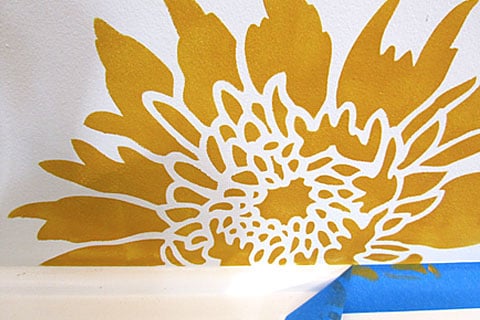
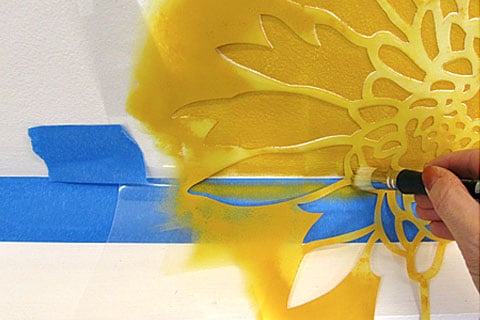
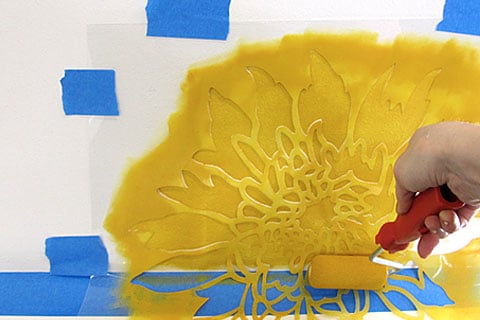
Stenciling Corners
This is achieved by beginning masking off the reverse wall, and angle the stencil into the corner. Secure the stencil with tape only on the side of the wall that you are stenciling, and roll right into the corner. Then use a stencil brush to get deep into the corner crease to fill in all the openings. Once you accept completed the print on the start wall, remove the stencil, and tape off the wall you lot accept just completed. Then, align the stencil with the print on your completed wall, secure with tape the function of the stencil that you'll be painting on a new wall, leaving the other half loose. Continue stenciling on the side by side wall.
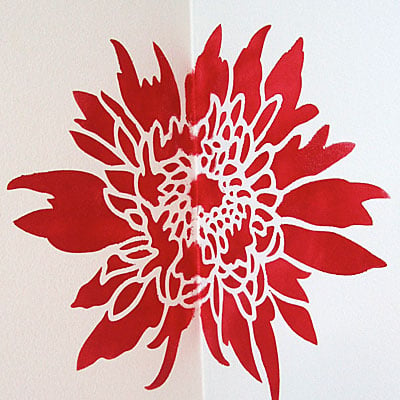
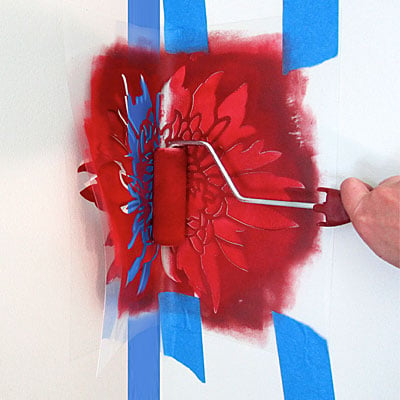
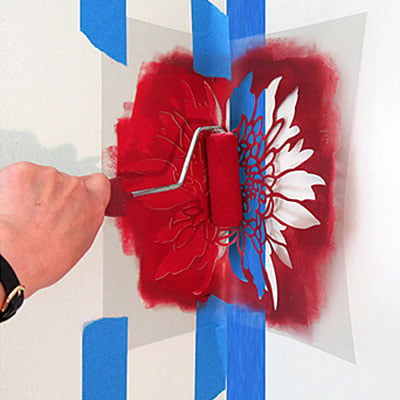
Clean Up
If you make clean your brushes, rollers and stencils as soon every bit you lot are done with your project, the paint comes off much easier. Don't soak your stencil brushes for a long fourth dimension: the natural beard expand and may divide the metal ferrule. Using a driblet of castor cleaner or Murphy's Oil Soap works well for cleaning brushes. Using a Castor scrubbing tool helps to improve remove paint particles from the castor bristles. Don't let your brushes or roller dry out during the project. If you take a break, put them in a plastic baggie or cover with damp cloth.
Your stencil does not have to be cleaned subsequently each repeat. It'south time to clean the stencil when there is a noticeable accumulation of paint - usually subsequently quite a few repeats. In our experience, 10-15 repeats or more than. Often yous'd be able to stencil an entire medium size accent wall without cleaning the stencil. To clean your stencil, lay it on a flat surface such as a cut board or a cookie tray, spray it with h2o and gently scrub with a dish brush nether running water. Make sure you take a sink strainer in place to catch any paint pieces. If the paint on the stencil is very dry – nosotros call it "caked" – let is soak for a while before scrubbing it. Lay the cleaned stencil onto paper towels and pat or roll it dry with a curlicue of paper towels – works dandy!
It's not like shooting fish in a barrel to remove spray adhesive from the stencil, but we notice that the production chosen Signature Thread Spray It DK5 Glue Remover works actually well. Our stencils are very durable and with proper intendance and cleaning should last for years!
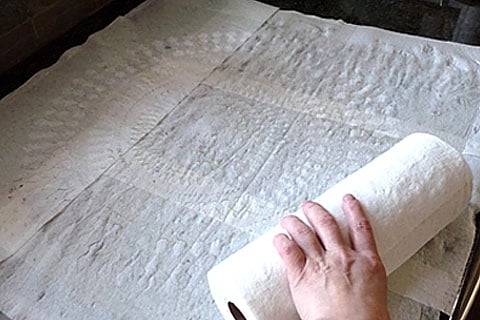
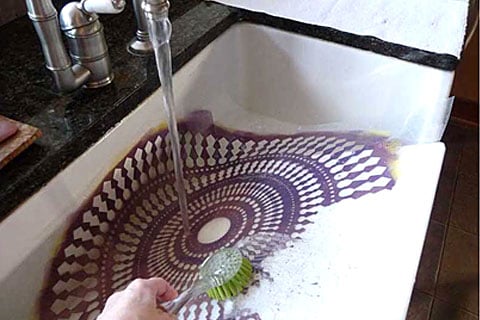
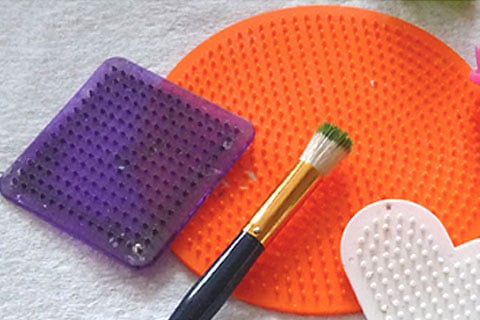
Stencil Storage
It'southward best to shop your stencil apartment whenever possible. We recommend placing your clean stencils between 2 pieces of paper or cardboard and storing them under the bed or fifty-fifty under an area rug!
Are you ready to stencil?
Stenciling is such an amazing and easy technique that opens the doors to endless decorative possibilities! Don't exist intimidated - exist inspired! Just follow these guidelines, and in no time you'll be stenciling similar a pro! Want to acquire more about stenciling? Check out our Web log or watch our informative and inspiring How To Stencil Videos! 
![]() @2021 - Cut Edge Stencils. All Right Reserved. Designed and Developed past DotcomWeavers.
@2021 - Cut Edge Stencils. All Right Reserved. Designed and Developed past DotcomWeavers.
Source: https://www.cuttingedgestencils.com/basic-stenciling-instructions-step-by-step.html
0 Response to "When Removing a Self Adhesive Stencil What Can They Be Placed on to Be Used Again"
Post a Comment